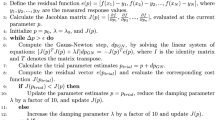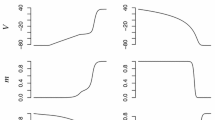Abstract
Mathematical modeling is an often used approach in biological science which, given some understanding of a system, is employed as a means of predicting future behavior and quantitative hypothesis testing. However, as our understanding of processes becomes more in depth, the models we use to describe them become correspondingly more complex. There is a paucity of effective methods available for sampling the vast objective surfaces associated with complex multiparameter models while at the same time maintaining the accuracy needed for local evaluation of minima—all in a practical time period. We have developed a series of modifications to the curvilinear gradient method for parameter optimization. We demonstrate the power and efficiency of our routine through fitting of a 22 parameter Markov state model to an electrophysiological recording of a cardiac ion channel. Our method efficiently and accurately locates parameter minima which would not be easily identified using the currently available means. While the computational overhead involved in implementing the curvilinear gradient method may have contributed to resistance to adopting this technique, the performance improvements allowed by our modifications make this an extremely valuable tool in development of models of complex biological systems.




Similar content being viewed by others
References
Audet C, Dennis JE Jr (2003) Analysis of generalized pattern searches. SIAM J Optim 13:889–903
Botsaris CA, Jacobson DH (1976) Newton-type curvilinear search method for optimization. J Math Anal Appl 54:217–229
Brent RP (1973) Algorithms for minimization without derivatives. Prentice-Hall, Englewood Cliffs, NJ
Conn AR, Scheinberg K, Vicente LN (2009) Introduction to derivative-free optimization. SIAM, Philadelphia
Dokos S, Lovell NH (2003) A curvilinear gradient path method for optimization of biological systems models. In: 5th IFAC symposium on modelling and control in biomedical systems, pp 203
Dokos S, Lovell NH (2004) Parameter estimation in cardiac ionic models. Prog Biophys Mol Biol 85:407–431
Edelstein-Keshet L (2005) Mathematical models in biology. Random House, New York
Fink M, Noble D (2009) Markov models for ion channels: versatility versus identifiability and speed. Philos Trans A Math Phys Eng Sci 367:2161–2179
Fletcher R (1987) Practical methods of optimization. Wiley, New York
Forrest S (1993) Genetic algorithms: principles of natural selection applied to computation. Science 261:872–878
Henzler-Wildman K, Kern D (2007) Dynamic personalities of proteins. Nature 450:964
Hodgkin AL, Huxley AF (1952) A quantitative description of membrane current and its application to conduction and excitation in nerve. J Physiol 117:500–544
Liu DC, Nocedal J (1989) On the limited memory BFGS method for large scale optimization. Math Program 45:503–528
Lu Y, Mahaut-Smith MP, Varghese A, Huang CL, Kemp PR et al (2001) Effects of premature stimulation on hERG K(+) channels. J Physiol 537:843–851
Marquardt D (1963) An algorithm for least-squares estimation of nonlinear parameters. J Soc Ind Appl Math 11:431–441
Michalewicz Z, Nazhiyath G (1995) Genocop III: a co-evolutionary algorithm for numerical optimization problems with nonlinear constraints. In: IEEE International conference on evolutionary computations, pp 647–651
Nocedal J, Wright SJ (2006) Numerical optimization. Springer-Verlag, New York
Press WH, Teukolsky SA, Vetterling WT, Flannery BP (1994) Numerical recipes in C: the art of scientific computing. Cambridge University Press, New York
Raguet-Schofield R (2009) Twittering with Mathematica. Wolfram Blog
Rovati GE (1990) A versatile implementation of the Gauss–Newton minimization algorithm using Matlab for Macintosh microcomputers. Comput Methods Programs Biomed 32:161–167
ten Tusscher KH, Panfilov AV (2006) Alternans and spiral breakup in a human ventricular tissue model. Am J Physiol Heart Circ Physiol 291:H1088–H1100
ten Tusscher KH, Noble D, Noble PJ, Panfilov AV (2004) A model for human ventricular tissue. Am J Physiol Heart Circ Physiol 286:H1573–H1589
Wolfram S (2007) The Mathematica book. Wolfram Research Inc., Champaign, IL
Zhao JT, Hill AP, Varghese A, Cooper AA, Swan H et al (2009) Not all hERG pore domain mutations have a severe phenotype: G584S has an inactivation gating defect with mild phenotype compared to G572S, which has a dominant negative trafficking defect and a severe phenotype. J Cardiovasc Electrophysiol 20:923–930
Acknowledgments
This study was supported by a Grant-in-aid from the National Heart Foundation of Australia (GO8S 3689). APH is a National Heart Foundation of Australia Fellow and JIV is an Australian National Health and Medical Research Council Senior Research Fellow.
Author information
Authors and Affiliations
Corresponding author
Electronic supplementary material
Below is the link to the electronic supplementary material.
Rights and permissions
About this article
Cite this article
Szekely, D., Vandenberg, J.I., Dokos, S. et al. An improved curvilinear gradient method for parameter optimization in complex biological models. Med Biol Eng Comput 49, 289–296 (2011). https://doi.org/10.1007/s11517-010-0667-1
Received:
Accepted:
Published:
Issue Date:
DOI: https://doi.org/10.1007/s11517-010-0667-1




